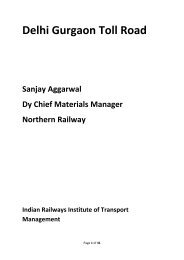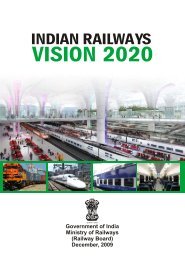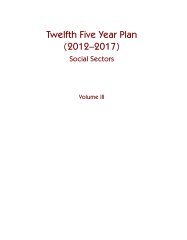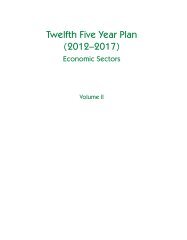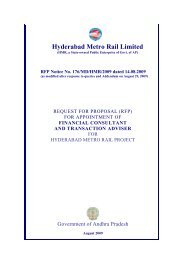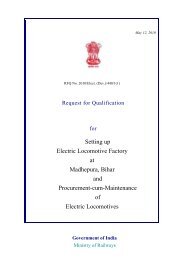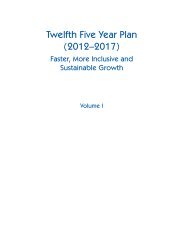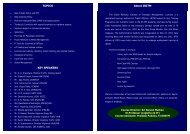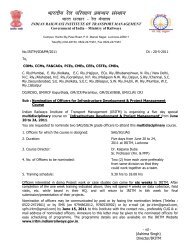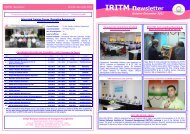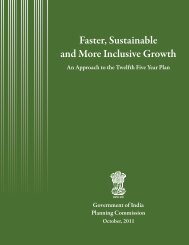IRITM_PP_Loco Links_TT - Indian Railways Institute of Transport ...
IRITM_PP_Loco Links_TT - Indian Railways Institute of Transport ...
IRITM_PP_Loco Links_TT - Indian Railways Institute of Transport ...
You also want an ePaper? Increase the reach of your titles
YUMPU automatically turns print PDFs into web optimized ePapers that Google loves.
Thursday, April 25, 2013 INDRA GHOSH, COM/NR Slide No. 1
Welcome to a Lecture on<br />
MAKING OF POWER PLAN<br />
CREW REQUIREMENT<br />
&<br />
TIME TABLING OF TRAINS<br />
Tele : +91 – 11 – 2338 – 7976<br />
Mobile : +91 – 97176 – 30900<br />
E – Mail : indra<strong>of</strong>fice@gmail.com<br />
by :<br />
INDRA GHOSH<br />
COM/NR<br />
Thursday, April 25, 2013 INDRA GHOSH, COM/NR Slide No. 2
DISCLAIMER<br />
Views expressed in this lecture are that<br />
<strong>of</strong> the speaker and may not necessarily<br />
reflect the <strong>of</strong>ficial views <strong>of</strong> either<br />
Northern Railway or <strong>of</strong> the Railway<br />
Board.<br />
Thursday, April 25, 2013 INDRA GHOSH, COM/NR Slide No. 3
Outline <strong>of</strong> the Lecture<br />
• Power Plan.<br />
• <strong>Loco</strong> links & Crew requirement.<br />
• Time Tabling <strong>of</strong> Trains.<br />
Thursday, April 25, 2013 INDRA GHOSH, COM/NR Slide No. 4
Outline <strong>of</strong> the Lecture<br />
• Power Plan.<br />
• <strong>Loco</strong> links & Crew requirement.<br />
• Time Tabling <strong>of</strong> Trains.<br />
Thursday, April 25, 2013 INDRA GHOSH, COM/NR Slide No. 5
Outline <strong>of</strong> the Lecture<br />
• Power Plan.<br />
Thursday, April 25, 2013 INDRA GHOSH, COM/NR Slide No. 6
Power Plan<br />
• Power plan is prepared by a division for assessing their<br />
daily requirement <strong>of</strong> locos on a long term basis.<br />
• It basically indicates the daily average number <strong>of</strong> locos<br />
required and planned for freight services, section wise*<br />
for each division.*<br />
• It helps in long term planning both for locos as also for<br />
crews.<br />
• At divisional level.<br />
– <strong>Loco</strong> holding.<br />
– Crew requirement.<br />
Thursday, April 25, 2013 INDRA GHOSH, COM/NR Slide No. 7
Power Plan<br />
• Power plan is prepared by a division for assessing their<br />
daily requirement <strong>of</strong> locos on a long term basis.<br />
• It basically indicates the daily average number <strong>of</strong> locos<br />
required and planned for freight services section wise* for<br />
each division.<br />
• It helps in long term planning for both locos as also for<br />
crews.<br />
• At divisional level.<br />
– <strong>Loco</strong> holding.<br />
– Crew requirement.<br />
• At Zonal level.<br />
• At Railway Board level.<br />
Thursday, April 25, 2013 INDRA GHOSH, COM/NR Slide No. 8
Power Plan<br />
• Method given in Operating Manual for working out the<br />
Power plan.*<br />
• Power plan consists <strong>of</strong> 3 components :<br />
– Main line services.<br />
– Inferior services.<br />
– Shunting locos.<br />
Thursday, April 25, 2013 INDRA GHOSH, COM/NR Slide No. 9
Power Plan<br />
• Method given in Operating Manual for working out the<br />
Power plan.<br />
• Power plan consists <strong>of</strong> 3 components :<br />
– Main line services.<br />
– Inferior services.<br />
– Shunting locos.<br />
• This exercise is to be carried out every six months.**<br />
• Bare requirement <strong>of</strong> locos for traffic use on a division is<br />
calculated :<br />
– on the basis <strong>of</strong> the traffic turn round and average<br />
number <strong>of</strong> trains run on each section.<br />
• Quite complicated and impractical.*<br />
Thursday, April 25, 2013 INDRA GHOSH, COM/NR Slide No. 10
Power Plan<br />
• Avg. no. <strong>of</strong> trains run on each section per day and Avg.<br />
hours on road for last six months*;<br />
– duly signed by Sr. DEE(Op)/Sr. DME(P) and<br />
Sr.DOM to be prepared.<br />
• Section wise average freight POL for the last six months<br />
to be calculated as under :<br />
– Bare POL = PDD + HOR + PAD*<br />
• 3.5% further growth and 10% bunching allowance to be<br />
demanded on Bare POL.<br />
Thursday, April 25, 2013 INDRA GHOSH, COM/NR Slide No. 11
Power Plan<br />
• <strong>Loco</strong> requirement for DMT, ART and other locos which<br />
remain in outage but not added in POL for the purpose <strong>of</strong><br />
calculation <strong>of</strong> average kilometers to be added in the bare<br />
requirement.*<br />
• To arrive at total POL, last six month average POL <strong>of</strong><br />
shunting loco link WDS 4 , WDS 5 pilots and Mail lie over<br />
powers to be added in the POL calculated above.*<br />
• Mail/Exp./Pass. loco requirement to be worked out on the<br />
basis <strong>of</strong> loco link.<br />
• Add 10% for major repair allowance.<br />
Thursday, April 25, 2013 INDRA GHOSH, COM/NR Slide No. 12
Power Plan<br />
• For shunting services, work out number <strong>of</strong> points for 8<br />
hours shunting, demand 0.33 POL.<br />
• Add 1 loco as overlap against 6 loco.<br />
• Add 10% for major repairs.<br />
• Kms formula :<br />
– Total kms earned per day on an average, during last<br />
six months divided by average loco utilization.<br />
Thursday, April 25, 2013 INDRA GHOSH, COM/NR Slide No. 13
Power Plan<br />
• My method <strong>of</strong> working out the power plan.<br />
• Power plan consists <strong>of</strong> 3 components :<br />
– Main line locos – including through goods and<br />
inferior services.*<br />
– Lie over powers <strong>of</strong> Mail/Express links.<br />
– Shunting locos.<br />
Thursday, April 25, 2013 INDRA GHOSH, COM/NR Slide No. 14
Power Plan<br />
• For through goods locos.<br />
– Highest daily POL in any one particular month within<br />
the division’s territorial jurisdiction.*<br />
Thursday, April 25, 2013 INDRA GHOSH, COM/NR Slide No. 15
Power Plan<br />
• For through goods locos.<br />
– Highest daily POL in any one particular month within<br />
the division’s territorial jurisdiction.*<br />
• For lie over powers <strong>of</strong> mail/express links.<br />
– Highest POL in any 8 hrs. shift on a daily basis.*<br />
Thursday, April 25, 2013 INDRA GHOSH, COM/NR Slide No. 16
Power Plan<br />
• For through goods locos.<br />
– Highest daily POL in any one particular month within<br />
the division’s territorial jurisdiction.*<br />
• For lie over powers <strong>of</strong> mail/express links.<br />
– Highest POL in any 8 hrs. shift on a daily basis.*<br />
• Add certain % as future growth based on average annual<br />
growth <strong>of</strong> last 3 years.*<br />
• This % should be added both for through goods locos as<br />
also for mail/express lie over locos.*<br />
• Add 10% bunching allowance for through goods only.<br />
Thursday, April 25, 2013 INDRA GHOSH, COM/NR Slide No. 17
Power Plan<br />
• For shunting locos :<br />
– Work out the total no. <strong>of</strong> shunting loco shifts on the<br />
division both for<br />
• Coaching yards.<br />
• Goods yards.<br />
Thursday, April 25, 2013 INDRA GHOSH, COM/NR Slide No. 18
Power Plan<br />
• For shunting locos :<br />
– Work out the total no. <strong>of</strong> shunting loco shifts on the<br />
division both for<br />
• Coaching yards.<br />
• Goods yards.<br />
• Add extra shifts required per day for transferring the<br />
shunting loco to/from the diesel shed.<br />
• Dividing by 3 gives gives the bare requirement <strong>of</strong><br />
shunting locos.<br />
• Add 10% for major repairs.<br />
• Round <strong>of</strong>f to the next higher integer.<br />
• Normally, no extra cushions are justified after this.<br />
Thursday, April 25, 2013 INDRA GHOSH, COM/NR Slide No. 19
Power Plan<br />
• Power plan is to be made separately for diesel and electric<br />
tractions.<br />
Thursday, April 25, 2013 INDRA GHOSH, COM/NR Slide No. 20
Outline <strong>of</strong> the Lecture<br />
• Power Plan.<br />
• <strong>Loco</strong> links & Crew requirement.<br />
Thursday, April 25, 2013 INDRA GHOSH, COM/NR Slide No. 21
<strong>Loco</strong> links<br />
• At the divisional level loco links <strong>of</strong> only passenger trains<br />
can be made.<br />
• <strong>Loco</strong> links <strong>of</strong> intra – railway express trains are prepared at<br />
hdqrts. level.*<br />
• <strong>Loco</strong> links <strong>of</strong> inter – railway express trains should be<br />
prepared at Board level.<br />
• However, these are also prepared at zonal railway, on<br />
pairing train basis.*<br />
• For small stretches which are not electrified it is better to<br />
super impose a diesel power on top <strong>of</strong> electric loco for<br />
traction bridging.<br />
Thursday, April 25, 2013 INDRA GHOSH, COM/NR Slide No. 22
Crew requirement<br />
• Crew requirement for mail/express trains is worked out on<br />
the basis <strong>of</strong> crew links.<br />
• Ideally, for mail/expresses, actual crew runs should be <strong>of</strong><br />
at least around 7 hrs. duration.<br />
• For all crew runs which are <strong>of</strong> less than 4 hrs. duration<br />
inter – divisional links should be made.<br />
• For making inter – divisional links, theory <strong>of</strong> train – kms.<br />
vis-a-vis guard kms. should be used for deciding<br />
ownership <strong>of</strong> that particular link.*<br />
• If an ab-initio exercise is done for re-working crew links<br />
there may be savings <strong>of</strong> at least 5%.*<br />
Thursday, April 25, 2013 INDRA GHOSH, COM/NR Slide No. 23
Crew requirement<br />
• Existing instructions/procedures do not ensure timely<br />
availability <strong>of</strong> crews for newly introduced coaching trains.<br />
• Every time a new express train is introduced, crew links<br />
are to be revised and additional crews for new train is to<br />
be incorporated in the link.<br />
• Problem comes up because :<br />
– sanction for additional crews can only be obtained<br />
after links are revised.<br />
– links can only be revised after introduction <strong>of</strong> new<br />
train.*<br />
Thursday, April 25, 2013 INDRA GHOSH, COM/NR Slide No. 24
Crew requirement<br />
• Crew review to be conducted once a year.<br />
• Hence, it cannot be undertaken every time a new train is<br />
introduced.<br />
• Problem <strong>of</strong> repeated requirement <strong>of</strong> manning additional<br />
trains throughout the year.<br />
• There is no problem for a division where only a single<br />
new train is to be run.<br />
• But what about a division where 3 or 4 trains are to be<br />
introduced throughout the year?<br />
• Since train cannot wait for sanction/promotion etc. crews<br />
are inducted from passenger link to express link, and<br />
– from freight services to passenger link.<br />
Thursday, April 25, 2013 INDRA GHOSH, COM/NR Slide No. 25
Crew requirement<br />
• Over a period <strong>of</strong> time, after all trains have been<br />
introduced, a one time crew review is done and posts are<br />
created.<br />
• On an average, there is a time lag <strong>of</strong> 6 to 8 months<br />
between introduction <strong>of</strong> trains and creation <strong>of</strong> posts.<br />
• For day to day train running, Leave Reserve available in<br />
passenger grade are put to working these trains.<br />
• LR for passenger trains is in turn provided from goods<br />
grade.<br />
• Final shortage in any case is felt in freight operations.<br />
Thursday, April 25, 2013 INDRA GHOSH, COM/NR Slide No. 26
Crew requirement<br />
• The exercise should begin in December every year, before<br />
announcement <strong>of</strong> new trains in railway budget.<br />
• A comprehensive zero based review <strong>of</strong> existing links<br />
should be undertaken to tighten up links.<br />
• After announcement <strong>of</strong> new trains in budget, division<br />
should follow the modus operandi explained below :<br />
• Total daily train kilometres (TDKM) to be added on<br />
account <strong>of</strong> these new trains should be worked out.<br />
• Average daily kms. earned by mail/express drivers on the<br />
basis <strong>of</strong> their existing links is already known for each<br />
division.<br />
Thursday, April 25, 2013 INDRA GHOSH, COM/NR Slide No. 27
Crew requirement<br />
• No. <strong>of</strong> additional posts required for new trains should be<br />
worked out in advance based on the above.<br />
• 30% LR must be added to this bare requirement.<br />
• Based on this, divisions should propose and create posts<br />
for all new trains to be introduced throughout the year.<br />
• However, these posts will be operated in phases as and<br />
when each train is introduced and existing links are<br />
revised.<br />
• No. <strong>of</strong> posts to be operated for each train would depend<br />
on the revised link + 30% Leave Reserve.<br />
Thursday, April 25, 2013 INDRA GHOSH, COM/NR Slide No. 28
Crew requirement<br />
• Powers on Line (POL) is the single most important factor<br />
for working out requirement <strong>of</strong> crews.<br />
• It is not dependent on Duty hours <strong>of</strong> crew, Hours on<br />
Road, No. <strong>of</strong> trains run, Power Plan, Traffic projections,<br />
etc.*<br />
• Similarly if cushions are required to be added for working<br />
out the requirement they have to be based on certain logic.<br />
• Cushions added cannot be ad – hoc, just because we do<br />
not want to manage efficiently.<br />
Thursday, April 25, 2013 INDRA GHOSH, COM/NR Slide No. 29
Crew requirement<br />
• Number <strong>of</strong> crews required at any point <strong>of</strong> time is directly<br />
related to number <strong>of</strong> loco units available on the division.<br />
• For this purpose, Multis and Consists are taken as 1 loco<br />
unit.<br />
• Fundamental principle <strong>of</strong> crew requirement.<br />
• Whether a loco is stationary or performing shunting or<br />
earning 600 Kms. per day, it has to be manned by a<br />
driver.<br />
• Crew review freight should be done based on the<br />
requirement <strong>of</strong> 7.6 crews/POL.*<br />
Thursday, April 25, 2013 INDRA GHOSH, COM/NR Slide No. 30
Crew requirement<br />
• Crew shortage is a perennial problem that every division<br />
faces.**<br />
• Time lag between processing <strong>of</strong> case and actual<br />
availability <strong>of</strong> bodies after training is almost 3 years.*<br />
• Anticipated vacancies for next 3 years should be taken.**<br />
• This will be as per the existing crew strength.<br />
• Anticipated increase in crew strength, based on past 3<br />
years growth, both for :<br />
– Express trains,<br />
– Freight services.<br />
Thursday, April 25, 2013 INDRA GHOSH, COM/NR Slide No. 31
Crew requirement<br />
• Crew shortage is a perennial problem that every division<br />
faces.**<br />
• Time lag between processing <strong>of</strong> case and actual<br />
availability <strong>of</strong> bodies after training is almost 3 years.*<br />
• Anticipated vacancies for next 3 years should be taken.**<br />
• This will be as per the existing crew strength.<br />
• Anticipated increase in crew strength, based on past 3<br />
years growth, both for :<br />
– Express trains,<br />
– Freight services.<br />
• Entire panel from RRB need not be operated.*<br />
Thursday, April 25, 2013 INDRA GHOSH, COM/NR Slide No. 32
Outline <strong>of</strong> the Lecture<br />
• Power Plan.<br />
• <strong>Loco</strong> links & Crew requirement.<br />
• Time Tabling <strong>of</strong> Trains.<br />
Thursday, April 25, 2013 INDRA GHOSH, COM/NR Slide No. 33
Time Tabling <strong>of</strong> Trains<br />
• May appear to be simple exercise to a layman.*<br />
• It is both a science as also an art.<br />
• It is a science because there are certain rules and<br />
guidelines laid down for time tabling.<br />
• It is also an art because application <strong>of</strong> these rules and<br />
guidelines have to be tempered with judicious mixture <strong>of</strong> :<br />
– user requirement,<br />
– passenger sensitivity,<br />
– local characteristics,<br />
– operational constraints, and<br />
– other factors that are part <strong>of</strong> day to day operations.<br />
Thursday, April 25, 2013 INDRA GHOSH, COM/NR Slide No. 34
Time Tabling <strong>of</strong> Trains<br />
• When a new train is to be introduced, rarely do we come<br />
across a case where everything is laid out for us.<br />
• In most cases :<br />
– spare terminal capacity will probably not exist,<br />
– clear cut washing line slot will not be available,<br />
– stabling line berths would not be spare, etc.<br />
Thursday, April 25, 2013 INDRA GHOSH, COM/NR Slide No. 35
Time Tabling <strong>of</strong> Trains<br />
• When a new train is to be introduced, rarely do we come<br />
across a case where everything is laid out for us.<br />
• In most cases :<br />
– spare terminal capacity will probably not exist,<br />
– clear cut washing line slot will not be available,<br />
– stabling line berths would not be spare, etc.<br />
• Under such circumstances, changes will have to be made<br />
in the present time schedule <strong>of</strong> some existing trains to<br />
accommodate this new train.<br />
Thursday, April 25, 2013 INDRA GHOSH, COM/NR Slide No. 36
Time Tabling <strong>of</strong> Trains<br />
• There are 4 distinct categories <strong>of</strong> trains whose<br />
requirements are different as far as time tabling is<br />
concerned :<br />
– High speed Rajdhani/Duronto/Shatabdi Expresses.<br />
– Mail/Expresses and other Inter – city trains.<br />
– Suburban services.<br />
– Passenger trains.<br />
Thursday, April 25, 2013 INDRA GHOSH, COM/NR Slide No. 37
Time Tabling <strong>of</strong> Trains<br />
• Criteria for deciding on the arrival and departure time :<br />
– Type <strong>of</strong> service,*<br />
– Duration <strong>of</strong> journey,*<br />
– Terminal which has the most severe constraint,*<br />
– Washing line,*<br />
– Stabling line,*<br />
– Platform availability,*<br />
Thursday, April 25, 2013 INDRA GHOSH, COM/NR Slide No. 38
Time Tabling <strong>of</strong> Trains<br />
• Criteria for deciding on the arrival and departure time :<br />
– Type <strong>of</strong> service,*<br />
– Duration <strong>of</strong> journey,*<br />
– Terminal which has the most severe constraint,*<br />
– Washing line,*<br />
– Stabling line,*<br />
– Platform availability,*<br />
– Actual path available for getting into a major<br />
terminal,<br />
– Rake link.*<br />
Thursday, April 25, 2013 INDRA GHOSH, COM/NR Slide No. 39
Time Tabling <strong>of</strong> Trains<br />
• Criteria for deciding on the arrival and departure time :<br />
– Type <strong>of</strong> service,*<br />
– Duration <strong>of</strong> journey,*<br />
– Terminal which has the most severe constraint,*<br />
– Washing line,*<br />
– Stabling line,*<br />
– Platform availability,*<br />
– Actual path available for getting into a major<br />
terminal,<br />
– Rake link.*<br />
• Different scenarios worked out, 2 – 3 alternatives listed.<br />
• Adjustments made in timings <strong>of</strong> existing trains.<br />
Thursday, April 25, 2013 INDRA GHOSH, COM/NR Slide No. 40
Time Tabling <strong>of</strong> Trains<br />
• Actual charting <strong>of</strong> the train is carried out based on :<br />
– Maximum permissible and booked speed,*<br />
– Bare running time,<br />
– Permanent speed restrictions,<br />
– Stoppages and their duration,<br />
– Acceleration and deceleration,<br />
– Engineering recovery time,<br />
– Traffic recovery time,<br />
– Crossings and precedence,<br />
– Platform berthing at intermediate stations,<br />
– Attaching detaching <strong>of</strong> slip coaches, if any,<br />
– Traction changing, if any.<br />
Thursday, April 25, 2013 INDRA GHOSH, COM/NR Slide No. 41
Time Tabling <strong>of</strong> Trains<br />
• Maximum permissible speed differs from section to<br />
section.<br />
• It can also differ from train to train on the same section.<br />
• Depends on the following :<br />
– Track structure,<br />
– Type <strong>of</strong> locomotive,<br />
– Type <strong>of</strong> coaches,<br />
– Load <strong>of</strong> the train.<br />
Thursday, April 25, 2013 INDRA GHOSH, COM/NR Slide No. 42
Time Tabling <strong>of</strong> Trains<br />
• Maximum permissible speed differs from section to<br />
section.<br />
• It can also differ from train to train on the same section.<br />
• Depends on the following :<br />
– Track structure,<br />
– Type <strong>of</strong> locomotive,<br />
– Type <strong>of</strong> coaches,<br />
– Load <strong>of</strong> the train.<br />
• Booked speed <strong>of</strong> the train is usually kept at 90% <strong>of</strong> the<br />
maximum permissible speed.*<br />
• This margin <strong>of</strong> 10% is called loco recovery time.*<br />
Thursday, April 25, 2013 INDRA GHOSH, COM/NR Slide No. 43
Time Tabling <strong>of</strong> Trains<br />
• Bare running time is calculated by means <strong>of</strong> a calculator,<br />
– by dividing the length <strong>of</strong> the block section by the<br />
booked speed,<br />
– then adding the time lost due to permanent speed<br />
restrictions, and finally<br />
– rounding <strong>of</strong>f to the nearest minute.*<br />
Thursday, April 25, 2013 INDRA GHOSH, COM/NR Slide No. 44
Time Tabling <strong>of</strong> Trains<br />
• Other factors which should also be taken into<br />
consideration for calculating bare running time include :<br />
– Time loss on account <strong>of</strong> brake feel test.*<br />
– Time loss on account <strong>of</strong> switching over from North<br />
line to South line or vice – versa.<br />
Thursday, April 25, 2013 INDRA GHOSH, COM/NR Slide No. 45
Time Tabling <strong>of</strong> Trains<br />
• Other factors which should also be taken into<br />
consideration for calculating bare running time include :<br />
– Time loss on account <strong>of</strong> brake feel test.*<br />
– Time loss on account <strong>of</strong> switching over from North<br />
line to South line or vice – versa.<br />
• These are generally not considered at present.<br />
• As a result they get adjusted against TR time on run.*<br />
Thursday, April 25, 2013 INDRA GHOSH, COM/NR Slide No. 46
Time Tabling <strong>of</strong> Trains<br />
• Stoppages and their duration depend on :<br />
– Type <strong>of</strong> service,<br />
– Commercial requirement for :<br />
– Entraining/detraining,<br />
– Reservation quota,<br />
– Meal halts,<br />
– Loading/unloading <strong>of</strong> parcels.<br />
Thursday, April 25, 2013 INDRA GHOSH, COM/NR Slide No. 47
Time Tabling <strong>of</strong> Trains<br />
• Stoppages and their duration depend on :<br />
– Type <strong>of</strong> service,<br />
– Commercial requirement for :<br />
– Entraining/detraining,<br />
– Reservation quota,<br />
– Meal halts,<br />
– Loading/unloading <strong>of</strong> parcels.<br />
– Operational requirements include :<br />
– Watering stations,<br />
– Crew changing points, etc.<br />
Thursday, April 25, 2013 INDRA GHOSH, COM/NR Slide No. 48
Time Tabling <strong>of</strong> Trains<br />
• Time taken for acceleration and deceleration varies from<br />
train to train depending on a number <strong>of</strong> factors.<br />
• Earlier, uniform time <strong>of</strong> 2’ for acceleration and 1’ for<br />
deceleration used to be taken.<br />
• Presently, we follow a graded scale depending on :<br />
– Speed <strong>of</strong> the train,<br />
– Load,<br />
– Type <strong>of</strong> station,<br />
– Type <strong>of</strong> locomotive,<br />
– Type <strong>of</strong> coaches.<br />
Thursday, April 25, 2013 INDRA GHOSH, COM/NR Slide No. 49
Time Tabling <strong>of</strong> Trains<br />
• Time taken for acceleration and deceleration varies from<br />
train to train depending on a number <strong>of</strong> factors.<br />
• Earlier, uniform time <strong>of</strong> 2’ for acceleration and 1’ for<br />
deceleration used to be taken.<br />
• Presently, we follow a graded scale depending on :<br />
– Speed <strong>of</strong> the train,<br />
– Load,<br />
– Type <strong>of</strong> station,<br />
– Type <strong>of</strong> locomotive,<br />
– Type <strong>of</strong> coaches.<br />
• Generally, the first 3 factors are taken into consideration.<br />
Thursday, April 25, 2013 INDRA GHOSH, COM/NR Slide No. 50
Time Tabling <strong>of</strong> Trains<br />
• Speed <strong>of</strong> the train (18 coaches) :<br />
Speed in kmph Acceleration Deceleration<br />
< 75 1’ 1’<br />
75 < 100 2’ 1’<br />
> 100 3’ 2’<br />
Thursday, April 25, 2013 INDRA GHOSH, COM/NR Slide No. 51
Time Tabling <strong>of</strong> Trains<br />
• Speed <strong>of</strong> the train (18 coaches) :<br />
Speed in kmph Acceleration Deceleration<br />
< 75 1’ 1’<br />
75 < 100 2’ 1’<br />
> 100 3’ 2’<br />
• Load <strong>of</strong> the train (90 kmph)<br />
Load in coaches Acceleration Deceleration<br />
≤ 18 2’ 1’<br />
≤ 18 3’ 1’<br />
Thursday, April 25, 2013 INDRA GHOSH, COM/NR Slide No. 52
Time Tabling <strong>of</strong> Trains<br />
• Type <strong>of</strong> station (18 coaches, 90 kmph.) :<br />
Type <strong>of</strong> station Acceleration Deceleration<br />
Road side 1’ 1’<br />
Intermediate 2’ 1’<br />
Major junction 3’ 2’<br />
Thursday, April 25, 2013 INDRA GHOSH, COM/NR Slide No. 53
Time Tabling <strong>of</strong> Trains<br />
• Type <strong>of</strong> station (18 coaches, 90 kmph.) :<br />
Type <strong>of</strong> station Acceleration Deceleration<br />
Road side 1’ 1’<br />
Intermediate 2’ 1’<br />
Major junction 3’ 2’<br />
• For combination <strong>of</strong> any <strong>of</strong> the above, namely speed, load<br />
and type <strong>of</strong> station, 1 / 2 minute extra should be added for<br />
every 1’ extra shown under each category.<br />
Thursday, April 25, 2013 INDRA GHOSH, COM/NR Slide No. 54
Time Tabling <strong>of</strong> Trains<br />
• ER time should be 10% <strong>of</strong> the bare running time or 8.7%<br />
<strong>of</strong> the total running time, rounded <strong>of</strong>f to the nearest<br />
minute.<br />
• To be provided as follows :<br />
– This should be around 6’ – 10’/100 kms.*<br />
– Usually evenly spread out over the entire section,<br />
both for single line and double line.<br />
– Last leg having 25% more than other sub – sections.<br />
– Should be provided in smaller block section so that<br />
line capacity is not adversely affected while plotting<br />
the master chart.<br />
Thursday, April 25, 2013 INDRA GHOSH, COM/NR Slide No. 55
Time Tabling <strong>of</strong> Trains<br />
• Suppose there are 4 sub – sections <strong>of</strong> a 400 km. section.<br />
– ER time comes to 40’.<br />
– Sub – section wise distribution would be 9’ for first 3<br />
and 12’ for last section.<br />
– Balancing can be done from one section to the other.*<br />
Thursday, April 25, 2013 INDRA GHOSH, COM/NR Slide No. 56
Time Tabling <strong>of</strong> Trains<br />
• TR time is provided in order to adjust for loss <strong>of</strong> time on<br />
account <strong>of</strong> unscheduled crossings and precedences.<br />
• TR time should be 5% <strong>of</strong> bare running time 4.8% <strong>of</strong> the<br />
total running time rounded <strong>of</strong>f to the nearest minute.<br />
• On double line sections :<br />
– this should be around 3’/100 kms.<br />
– evenly spread out over the entire section,<br />
– last leg having 25% more than other sub – sections.<br />
Thursday, April 25, 2013 INDRA GHOSH, COM/NR Slide No. 57
Time Tabling <strong>of</strong> Trains<br />
• On single line sections :<br />
– this should be around 5’/100 kms.<br />
– last sub – section having 50% TR <strong>of</strong> entire section,<br />
– remaining TR time being evenly distributed.<br />
Thursday, April 25, 2013 INDRA GHOSH, COM/NR Slide No. 58
Time Tabling <strong>of</strong> Trains<br />
• Both ER and TR time should not be provided in the same<br />
block section.<br />
• ER and TR time should be provided in the smaller block<br />
sections.*<br />
Thursday, April 25, 2013 INDRA GHOSH, COM/NR Slide No. 59
Time Tabling <strong>of</strong> Trains<br />
• Platform berthing at intermediate stations sometime<br />
becomes a problem in case vacant slots are not available.*<br />
• In that case ER/TR time is adjusted on either side <strong>of</strong> the<br />
intermediate station,<br />
– for this train, and<br />
– for other trains that are clashing with it.<br />
Thursday, April 25, 2013 INDRA GHOSH, COM/NR Slide No. 60
Time Tabling <strong>of</strong> Trains<br />
• Platform berthing at intermediate stations sometime<br />
becomes a problem in case vacant slots are not available.*<br />
• In that case ER/TR time is adjusted on either side <strong>of</strong> the<br />
intermediate station,<br />
– for this train, and<br />
– for other trains that are clashing with it.<br />
• Minor adjustment <strong>of</strong> up to 5’ can be made in this manner.<br />
Thursday, April 25, 2013 INDRA GHOSH, COM/NR Slide No. 61
Time Tabling <strong>of</strong> Trains<br />
• Crossings and precedence have to be so adjusted that the<br />
more important train goes through.<br />
• At the same time the less important train should not suffer<br />
excessive detention.<br />
• Operating time after a crossing depends on the system <strong>of</strong><br />
working :<br />
– Token system,<br />
– Tokenless system, or even<br />
– Automatic signalling system.<br />
Thursday, April 25, 2013 INDRA GHOSH, COM/NR Slide No. 62
Time Tabling <strong>of</strong> Trains<br />
• Crossings and precedence have to be so adjusted that the<br />
more important train goes through.<br />
• At the same time the less important train should not suffer<br />
excessive detention.<br />
• Operating time after a crossing depends on the system <strong>of</strong><br />
working :<br />
– Token system,<br />
– Tokenless system, or even<br />
– Automatic signalling system.<br />
• Sometimes fine tuning <strong>of</strong> crossings and precedence<br />
becomes a problem when it is observed that the less<br />
important train would suffer excessive detention.*<br />
Thursday, April 25, 2013 INDRA GHOSH, COM/NR Slide No. 63
Time Tabling <strong>of</strong> Trains<br />
• Extra time has to be provided for attaching/detaching <strong>of</strong><br />
slip coaches, if any.<br />
• The quantum <strong>of</strong> time would depend on :<br />
– whether shunting is by train engine or not,<br />
– whether coaches are to be attached or detached,<br />
– number <strong>of</strong> coaches,<br />
– position <strong>of</strong> coaches,<br />
– whether inside SLR or outside the SLR.<br />
Thursday, April 25, 2013 INDRA GHOSH, COM/NR Slide No. 64
Time Tabling <strong>of</strong> Trains<br />
• Extra time has to be provided for attaching/detaching <strong>of</strong><br />
slip coaches, if any.<br />
• The quantum <strong>of</strong> time would depend on :<br />
– whether shunting is by train engine or not,<br />
– whether coaches are to be attached or detached,<br />
– number <strong>of</strong> coaches,<br />
– position <strong>of</strong> coaches,<br />
– whether inside SLR or outside the SLR.<br />
• For traction changing normally 30’ time is provided for.<br />
Thursday, April 25, 2013 INDRA GHOSH, COM/NR Slide No. 65
Time Tabling <strong>of</strong> Trains<br />
• Stoppages at stations should be <strong>of</strong> 2’, 5’, 10’ or 15’<br />
duration.<br />
• Stoppages at road side stations should invariably be 2’.<br />
• Stoppages at intermediate junction stations should be 5’.<br />
• Stoppages at major junction stations should be <strong>of</strong> 10’ or<br />
15’ depending on the type <strong>of</strong> requirement.<br />
Thursday, April 25, 2013 INDRA GHOSH, COM/NR Slide No. 66
Time Tabling <strong>of</strong> Trains<br />
• A study was conducted in 1992, to calculate the cost <strong>of</strong><br />
stoppage <strong>of</strong> a train :<br />
– running with 22 coaches,<br />
– at 100 kmph.,<br />
– on a gradient <strong>of</strong> 1 : 500,<br />
– worked by WDM 2 loco.<br />
Thursday, April 25, 2013 INDRA GHOSH, COM/NR Slide No. 67
Time Tabling <strong>of</strong> Trains<br />
• A study was conducted in 1991, to calculate the cost <strong>of</strong><br />
stoppage <strong>of</strong> a train :<br />
– running with 22 coaches,<br />
– at 100 kmph.,<br />
– on a gradient <strong>of</strong> 1 : 500,<br />
– worked by WDM 2 loco.<br />
• On account <strong>of</strong> extra fuel consumed, wages and braking,<br />
the cost came to Rs. 750/- for a 2 minutes halt.<br />
• Costs have escalated by > 5 times since then.<br />
• Present day cost for stopping a train in both Up and Dn<br />
directions daily comes to Rs 30 lakhs per annum.<br />
Thursday, April 25, 2013 INDRA GHOSH, COM/NR Slide No. 68
Time Tabling <strong>of</strong> Trains<br />
• However, this calculation does not include :<br />
– costs <strong>of</strong> wastage <strong>of</strong> line capacity,<br />
– opportunity cost <strong>of</strong> deceleration <strong>of</strong> the train,<br />
– invisible and indirect costs <strong>of</strong> inconvenience caused to<br />
through passengers by poorer punctuality, and<br />
– aggravated overcrowding which does reflect in<br />
reduced earnings.<br />
Thursday, April 25, 2013 INDRA GHOSH, COM/NR Slide No. 69
Time Tabling <strong>of</strong> Trains<br />
• In principle IR should at least recover the bare cost <strong>of</strong><br />
providing a 2 minutes halt <strong>of</strong> a 22 coach train for every<br />
stoppage provided.<br />
• Even without taking the invisible costs including the<br />
inconveniences caused to a long distance passenger, etc.<br />
• This cost can be recovered for each such stoppage only if<br />
– a minimum <strong>of</strong> 30 passengers <strong>of</strong> mixed class entrain,<br />
– travel for a minimum distance <strong>of</strong> 500 kms.,<br />
– per trip,<br />
– in each direction.**<br />
Thursday, April 25, 2013 INDRA GHOSH, COM/NR Slide No. 70
Time Tabling <strong>of</strong> Trains<br />
• Following additional criteria may be borne in mind before<br />
consideration <strong>of</strong> any stoppage :<br />
– No stoppages should be provided when trains are<br />
passing at odd hours,<br />
– No additional stoppages should be provided to long<br />
distance trains in the suburban section,<br />
– No additional stoppage should be provided in<br />
sections having line capacity utilization above 90%.<br />
Thursday, April 25, 2013 INDRA GHOSH, COM/NR Slide No. 71
Time Tabling <strong>of</strong> Trains<br />
• Name <strong>of</strong> the Station.<br />
• Train no. whose stoppage is demanded.<br />
• Running between stations :<br />
– From.<br />
– To.<br />
• Time <strong>of</strong> passage <strong>of</strong> the train at the Station :<br />
– UP.<br />
– DN.<br />
• Average run <strong>of</strong> train between 2 stoppages.<br />
• Distance <strong>of</strong> stoppages on either side.<br />
Thursday, April 25, 2013 INDRA GHOSH, COM/NR Slide No. 72
Time Tabling <strong>of</strong> Trains<br />
• Length <strong>of</strong> train.<br />
• Platform length and availability.<br />
• Stoppage last provided at this station & date.<br />
• Sale <strong>of</strong> tickets after this stoppage.<br />
• Last stoppage provided to this train & date.<br />
• Other trains stopping for same destination.<br />
• Total number <strong>of</strong> trains stopping<br />
– Mail/Expresses :<br />
–UP.<br />
– DN.<br />
Thursday, April 25, 2013 INDRA GHOSH, COM/NR Slide No. 73
Time Tabling <strong>of</strong> Trains<br />
• Passenger trains :<br />
– UP.<br />
– DN.<br />
• Number <strong>of</strong> passengers & earning <strong>of</strong> last 6 months.<br />
• Number <strong>of</strong> passengers per day.<br />
• Number <strong>of</strong> passengers per stoppage.<br />
• Earning per day.<br />
• Earning per stoppage.<br />
• Minimum earning required.<br />
• Commercial justification.<br />
Thursday, April 25, 2013 INDRA GHOSH, COM/NR Slide No. 74
Time Tabling <strong>of</strong> Trains<br />
• Whether train will be decelerated or not, and<br />
– by how much.<br />
• Effect on punctuality <strong>of</strong> other trains.<br />
• Line capacity utilization <strong>of</strong> the section.<br />
• With maintenance block <strong>of</strong> 2 hrs. (should be < 90%)<br />
• Divisions recommendations.<br />
Thursday, April 25, 2013 INDRA GHOSH, COM/NR Slide No. 75
Time Tabling <strong>of</strong> Trains<br />
• Running <strong>of</strong> suburban services is different from that <strong>of</strong><br />
running other types <strong>of</strong> services.<br />
• Time tabling <strong>of</strong> suburban services does not follow the<br />
same logic as for other long distance trains.<br />
• All EMU, MEMU, DMU rakes are maintained in their<br />
Car sheds.<br />
• Hence, availability <strong>of</strong> washing lines, stabling lines etc. are<br />
no consideration at all.<br />
• Suburban services are constrained by 3 factors :<br />
– platform,<br />
– coaches,<br />
– path.<br />
Thursday, April 25, 2013 INDRA GHOSH, COM/NR Slide No. 76
Time Tabling <strong>of</strong> Trains<br />
• To some extent platform constraints can be got over with<br />
by :<br />
– Running these EMU rakes in a closed link, so that<br />
– each train after arrival at the platform is again run out<br />
as a new train.<br />
– Specific platforms are exclusively nominated for<br />
suburban trains during peak hours,<br />
– with directional movement.<br />
– This ensures that platform occupation does not<br />
exceed 10’ for each train.<br />
Thursday, April 25, 2013 INDRA GHOSH, COM/NR Slide No. 77
Time Tabling <strong>of</strong> Trains<br />
• The 2 nd constraint <strong>of</strong> suburban services is non –<br />
availability <strong>of</strong> coaches.<br />
• There is always heavy demand for these coaches.<br />
• Since these are specialised coaches, they are always in<br />
short supply,<br />
– as compared to the demand.<br />
• Maximum utilisation can only be achieved by working<br />
them to an optimum rake link.<br />
• However, in this case also, there are limitations.<br />
• Normally any one rake can at most undertake 2 incoming<br />
trips during the peak period.<br />
Thursday, April 25, 2013 INDRA GHOSH, COM/NR Slide No. 78
Time Tabling <strong>of</strong> Trains<br />
• Path problem is the 3 rd limiting factor that has now<br />
reached almost saturation levels.<br />
• Additional paths can be extracted to some extent by<br />
reducing the speed differential between successive trains.<br />
• This can be done by bunching together stopping and non<br />
– stopping trains.<br />
• However, the problem is that majority <strong>of</strong> commuters want<br />
to arrive in between 9/– hrs. and 9/30 hrs. only.<br />
• And there is a limit to the number <strong>of</strong> paths that can be<br />
squeezed out during this 1 / 2 hour time slot.<br />
• Thus even if more coaches are available some time in the<br />
future, it may not be possible to run additional trains.<br />
Thursday, April 25, 2013 INDRA GHOSH, COM/NR Slide No. 79
Time Tabling <strong>of</strong> Trains<br />
• Long term solution is to go in for longer rakes.<br />
– From 9 car rakes, we have gone on to 12 car rakes.<br />
– Trials with 15 car rakes have also been conducted.<br />
– Ultimately IR should aim at running 24 car rakes.<br />
– That will augment our existing carrying capacity by<br />
more than 100%.*<br />
Thursday, April 25, 2013 INDRA GHOSH, COM/NR Slide No. 80
Time Tabling <strong>of</strong> Trains<br />
• Standardization <strong>of</strong> coaching rakes was done with the<br />
objective <strong>of</strong> having standard compositions for different<br />
group <strong>of</strong> trains based at a particular maintenance depot.<br />
• It was expected that with standardization there would be<br />
substantial advantages.<br />
• These include :<br />
– flexibility <strong>of</strong> terminal operations by way <strong>of</strong> switching<br />
<strong>of</strong> passenger rakes on a first – in, first – out basis,<br />
– substantially reduce cancellation <strong>of</strong> trains or putting<br />
back <strong>of</strong> trains due to late running or dislocations,<br />
– provision <strong>of</strong> an overlapping rake at such terminals<br />
would ensure right time starts to all trains.<br />
Thursday, April 25, 2013 INDRA GHOSH, COM/NR Slide No. 81
Time Tabling <strong>of</strong> Trains<br />
• At certain locations where a number <strong>of</strong> rakes are based for<br />
primary maintenance, standardization has proved to be<br />
extremely beneficial.<br />
• Difficulties faced in complete implementation <strong>of</strong> this<br />
concept :<br />
– At secondary terminals switching <strong>of</strong> rakes posed<br />
practical problems involving staff, catering and<br />
maintenance.*<br />
– At primary maintenance terminals, trains going to<br />
separate destinations have different requirement <strong>of</strong><br />
AC and non – AC coaches.*<br />
Thursday, April 25, 2013 INDRA GHOSH, COM/NR Slide No. 82
Time Tabling <strong>of</strong> Trains<br />
• Practically it is better to have integrated rake links rather<br />
than go in for standardization.*<br />
• This can solve many <strong>of</strong> the problems related to staff,<br />
catering, maintenance etc.<br />
Thursday, April 25, 2013 INDRA GHOSH, COM/NR Slide No. 83
Time Tabling <strong>of</strong> Trains<br />
• Running <strong>of</strong> passenger trains is slightly different from that<br />
<strong>of</strong> running other types <strong>of</strong> services.<br />
• All passenger trains run on an integrated rake link where<br />
one single rake may work upto 12 pairs <strong>of</strong> trains,<br />
– before it gets maintained at one <strong>of</strong> the terminals.<br />
• Present instructions are that a rake must get maintained<br />
once every 3500 kms.<br />
• Main objective is to come up with rake links where<br />
maximum utilisation can be achieved.<br />
• Since these are comparatively slow moving trains, paths<br />
and terminal facilities do not play a significant role in<br />
planning for passenger trains.<br />
Thursday, April 25, 2013 INDRA GHOSH, COM/NR Slide No. 84
Time Tabling <strong>of</strong> Trains<br />
• Passenger services are generally restricted by only 2<br />
constraints.<br />
– availability <strong>of</strong> coaches,<br />
– availability <strong>of</strong> locos.<br />
• Passenger services are a losing proposition for IR.<br />
• Conscious efforts are therefore made to restrict the<br />
number <strong>of</strong> such services to the bare minimum.<br />
Thursday, April 25, 2013 INDRA GHOSH, COM/NR Slide No. 85
Time Tabling <strong>of</strong> Trains<br />
• It is necessary to make a significant improvement in the<br />
running <strong>of</strong> these services :<br />
– in order to improve overall operations <strong>of</strong> IR,<br />
– provide better quality <strong>of</strong> service to passengers, and<br />
– improve IR’s overall image.<br />
• During last couple <strong>of</strong> years, certain technically superior<br />
services have been introduced in certain selected sections<br />
by way <strong>of</strong> replacement <strong>of</strong> existing passenger services.<br />
• These include :<br />
– MEMUs,<br />
– DMUs.<br />
Thursday, April 25, 2013 INDRA GHOSH, COM/NR Slide No. 86
Time Tabling <strong>of</strong> Trains<br />
• For branch line sections having very low traffic, rail bus<br />
is the ideal solution.<br />
• It is exactly what its name means – a rail bus.<br />
• 70 seater with a driving cab at either end.*<br />
• Provides fast and frequent service on dead ended sections.<br />
• Full train load <strong>of</strong> passengers may not be available at one<br />
time, but at short intervals,<br />
– a bus load <strong>of</strong> passengers are available.<br />
• In operation between Merta Road and Merta City,<br />
– 15 kms. dead end section,<br />
– 12 round trips.<br />
Thursday, April 25, 2013 INDRA GHOSH, COM/NR Slide No. 87
Review<br />
• Power Plan.<br />
• <strong>Loco</strong> links & Crew requirement.<br />
• Time Tabling <strong>of</strong> Trains.<br />
Thursday, April 25, 2013 INDRA GHOSH, COM/NR Slide No. 88
Power Plan, <strong>Loco</strong> <strong>Links</strong> & Time Tabling<br />
Any<br />
questions<br />
please ?<br />
Thursday, April 25, 2013 INDRA GHOSH, COM/NR Slide No. 89
Thank You<br />
Thursday, April 25, 2013 INDRA GHOSH, COM/NR Slide No. 90
MAKING OF POWER PLAN<br />
LOCO LINKS<br />
&<br />
TIME TABLING OF TRAINS<br />
Tele : +91 – 11 – 2338 – 7976<br />
Mobile : +91 – 97176 – 30900<br />
E – Mail : com@nr.railnet.gov.in<br />
by :<br />
INDRA GHOSH<br />
COM/NR<br />
Thursday, April 25, 2013 INDRA GHOSH, COM/NR Slide No. 91
Thursday, April 25, 2013 INDRA GHOSH, COM/NR Slide No. 92
Power Plan<br />
• First Line.<br />
• AAA.<br />
• BBB.<br />
• CCC.<br />
• DDD.<br />
• EEE.<br />
• FFF.<br />
• GGG.<br />
• HHH.<br />
• III.<br />
• JJJ.<br />
• Last Line.<br />
Thursday, April 25, 2013 INDRA GHOSH, COM/NR Slide No. 93




